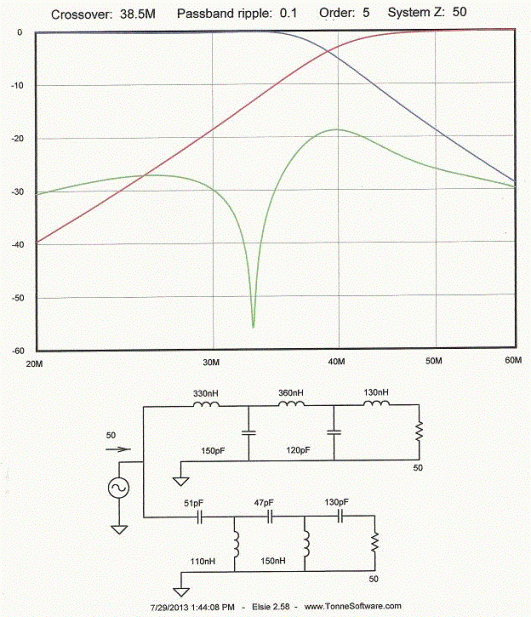Why do you need a diplexer? – The IC-7300 has only one antenna port for all bands from 160m through 4 metres.
As there is no antenna that I know of that covers all of these bands, this means that an external coax-switch must be used to manually switch between the relevant antennas, this is a less than perfect solution.
It should at least be possible to automatically switch between a HF antenna and a VHF one. As my HF antenna covers 80m through 10m and my VHF antenna is a tri-band 6m + 4m + 2m one ( A DK7ZB designed Yagi – available from here: http://www.vpa-systems.pl/triband-yagi-dk7zb-5070144-mhz-223el-120cm-p-30.html) a circuit that splits receive and transmitted RF somewhere between 30MHz and 50MHz would be good.
This is exactly what the Diplexer I have built does. A diplexer consists of a high pass filter and a low-pass filter, set to the correct frequencies. While we don’t have to hit the exact frequency but simply somewhere within a frequency range, I was able to use some pre-wound coils (usually used in model railway equipment) instead of having to wind the exact coils myself. There are online calculators that tell you how many turns of what gauge wire at what diameter are required to create exact inducatances however as my LC meter does not reliably show inductance values down at these values, it was better to use standard inductances and use the ELSIE program to calculate what the capacitors to go with the standard inductances would be. Note the capitors have to be non-inductive and RF compatible – Silver Mica ones are best.
What the circuit is is two filters, one high pass, and one low pass. Horizontal inductors shunted to ground with caps, create a low pass filter. When the caps are horizontal and the inductors go to ground, you have a high pass filter.
Here are some pictures of my completed diplexer – as you can see I have built it into a standard cast metal case simply soldering “manhatten style”. The result looks quite rough but it works well.
References:
https://electronics.stackexchange.com/questions/78634/analyze-my-homebrew-diplexer
There’s a link on this webpage to a PDF document from VK3ATL on the subject as well.
https://www.ka6wke.net/hf-vhf-diplexer


You must be logged in to post a comment.